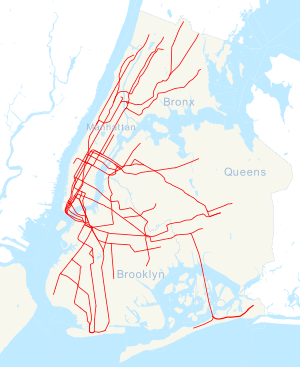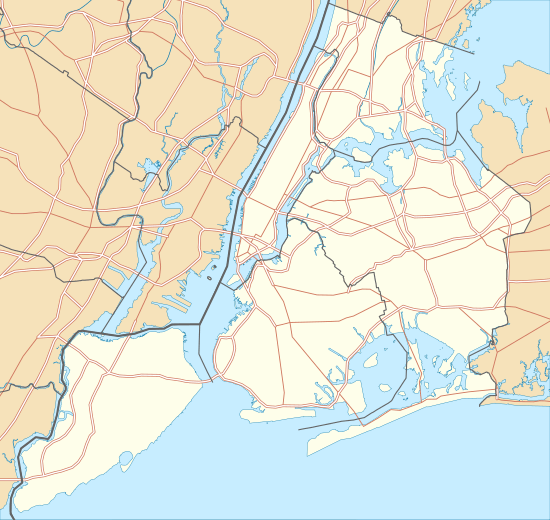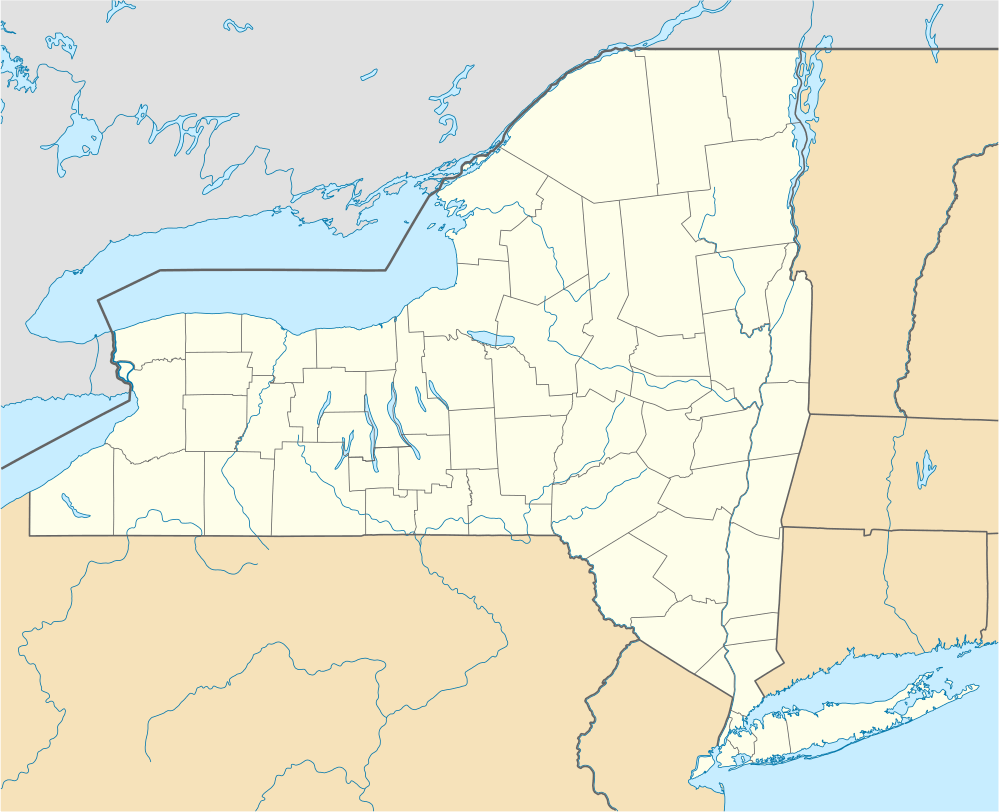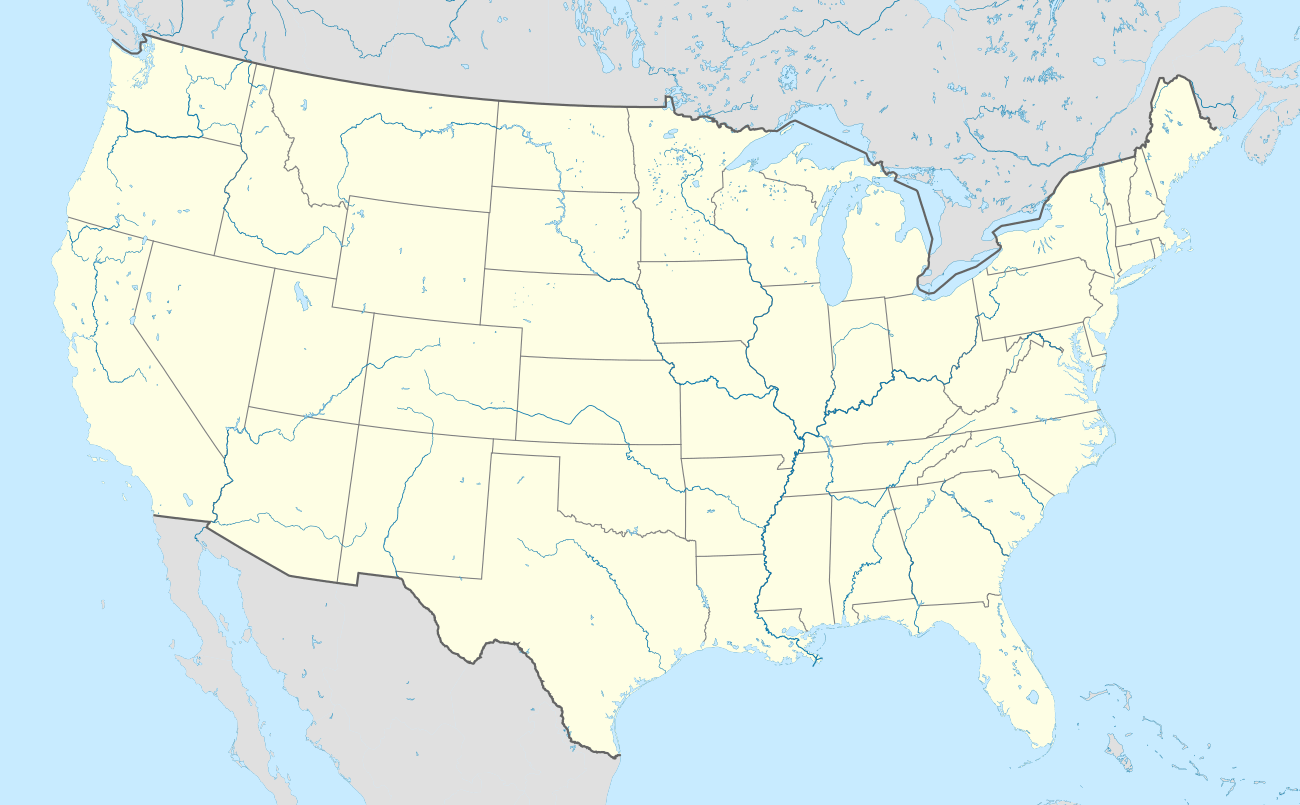96th Street (IRT Broadway–Seventh Avenue Line)
96 Street | |||||||||||
|---|---|---|---|---|---|---|---|---|---|---|---|
|
| |||||||||||
|
Uptown island platform | |||||||||||
| Station statistics | |||||||||||
| Address |
West 96th Street & Broadway New York, NY 10025 | ||||||||||
| Borough | Manhattan | ||||||||||
| Locale | Upper West Side | ||||||||||
| Coordinates | 40°47′39″N 73°58′19″W / 40.7941°N 73.972°WCoordinates: 40°47′39″N 73°58′19″W / 40.7941°N 73.972°W | ||||||||||
| Division | A (IRT) | ||||||||||
| Line | IRT Broadway–Seventh Avenue Line | ||||||||||
| Services |
1 2 3 | ||||||||||
| Transit connections |
| ||||||||||
| Structure | Underground | ||||||||||
| Platforms |
2 island platforms (in service) cross-platform interchange 2 side platforms (abandoned) | ||||||||||
| Tracks | 4 | ||||||||||
| Other information | |||||||||||
| Opened | October 27, 1904[1] | ||||||||||
| Station code | 310[2] | ||||||||||
| Accessible |
| ||||||||||
| Wireless service |
| ||||||||||
| Traffic | |||||||||||
| Passengers (2017) |
11,948,981[4] | ||||||||||
| Rank | 24 out of 425 | ||||||||||
| Station succession | |||||||||||
| Next north |
157th Street (Broadway–7th express): no regular service Central Park North–110th Street (Lenox): 2 103rd Street (Broadway–7th local): 1 | ||||||||||
| Next south |
91st Street (local; closed): no service 86th Street (local): 1 72nd Street (express): 2 | ||||||||||
|
| |||||||||||
| Next |
231st Street (via Broadway–7th): 1 135th Street (via Lenox): 2 | ||||||||||
| Next |
72nd Street: 1 | ||||||||||
| |||||||||||
| |||||||||||
| |||||||||||
96th Street is an express station on the IRT Broadway–Seventh Avenue Line of the New York City Subway. Located at the intersection of 96th Street and Broadway on the Upper West Side of Manhattan, it is served by the 1, 2 and 3 trains at all times.
96th Street station was part of the original IRT subway and opened on the inaugural date of October 27, 1904.[1] At the time, the station served as the terminus of local trains; express trains would run as locals north to 145th Street.[5]
Station layout
| G | Street level | Fare control |
| M | Mezzanine | Crossover |
| P Platform Level |
Side platform, not in service, used for maintenance and fare control | |
| Northbound local | ← (No service: 157th Street) ← | |
| Island platform, doors will open on the left, right | ||
| Northbound express | ← ← | |
| Southbound express | → → | |
| Island platform, doors will open on the left, right | ||
| Southbound local | → → (No service: 91st Street) | |
| Side platform, not in service, used for maintenance and fare control | ||
Currently, 96th Street operates in the same manner as other normal express stations in the subway system.[6] There are two island platforms that allow for cross-platform interchanges between local (outer tracks) and express (inner tracks) trains heading in the same direction, in this case uptown or downtown.[6]
During normal service, southbound local trains use track B1 and southbound express trains use track B2. Northbound express trains use track B3 and northbound local trains use track B4. These track designations are not posted in the station, but are used in the chaining of each individual track, used to measure distance by train crews on the subway.[7]
North of 96th Street, the express tracks descend and turn east under West 104th Street and running northeast under Central Park on their way to the IRT Lenox Avenue Line at West 110th Street. The local tracks remain on the upper level to Riverdale, Bronx. After the express tracks diverge, a currently unused center track starts at approximately 100th Street. Some last minute design changes added the third track northbound, and a provision for a third track was also built into the lower level Lenox branch of the junction. This accounts for the extra space seen alongside the active tracks in this area.
The station was extended and widened in 1950 to accommodate longer trains. The extent of the original station is clearly visible, as the renovation was not done in the same style. Differences in the walls and ceiling are visible at the south end. The creation of a new entrance at 94th Street led to the closure of the 91st Street station, as it would have been pointless to lengthen it for 10-car local trains with an adjacent station only a few blocks away.[6]
Unused side platforms
Access to the station was originally from stairways along the sidewalks of Broadway, to the extreme north end of the side platforms, then to the center island platforms via an underpass.[6] As of April 5, 2010, a new headhouse in Broadway's center median between 96th and 95th Streets rendered those entrances obsolete. New staircases and elevators descend to the platforms from the central station building. A former public restroom now being used as a community center in the median of Broadway north of 96th Street is sometimes mistaken for a former subway station headhouse; however, this structure was built decades after the subway station and conforms to the design of other public restroom buildings in New York City[8] rather than to the design of IRT subway headhouses such as 72nd Street.
The station's configuration, with both island and side platforms, is unusual in the New York City Subway. As originally intended, the island platforms facilitated an easy transfer between local and express trains, while the shorter side platforms provided easy access from local trains to the street. This design was also utilized at Brooklyn Bridge–City Hall and 14th Street–Union Square on the IRT Lexington Avenue Line. When the subway first opened, it was possible to open both sides of the train at once. As this is not practical on more modern trains, only the doors facing the island platforms are used (to permit transfers between local and express trains), and the side platforms were abandoned.[6]
Work is currently underway to turn the unused side platforms and former entrance/exits into storage space and offices. Switching system panels can be seen through new windows on the now walled off western side platform.
Station renovation and new headhouse
By 1981, the MTA had listed the station among the 69 most deteriorated stations in the subway system.[9] In July 2006, Manhattan Community Board 7 approved an $80 million renovation of the station. Construction started in 2007 on a state-of-the-art headhouse in the median of Broadway between 95th and 96th Streets, with wheelchair-accessible elevators to the platforms; Broadway was reconfigured for four blocks to accommodate this. By 2008, renovation of the 40,000 square feet (3,716 m2) station was nearly finished below budget (only $65 million was used to complete the renovation) and on schedule.[10] By 2009, the opening of the new headhouse was set to be 20 months early and $26 million cheaper due to budget cuts.[11][12] The new headhouse opened on April 5, 2010 and replaced the underpass and side platforms.[13] The side platforms became office and control space, and the entrances removed to accommodate narrowed sidewalks resulting from the roadway being displaced by the new headhouse and its island.[14]
All of the beige tiles installed in the 1950s were removed and either revealed original tiles or were replaced with new tiles. The elevators opened on November 9, 2010 making the station ADA-accessible.[15]
Local residents have voiced dissatisfaction with the significant loss of sidewalks adjacent to businesses.[16] Also, the intersection of 96th Street and Broadway is dangerous, making the crossing to the new station entrance "treacherous".[17]
Exits
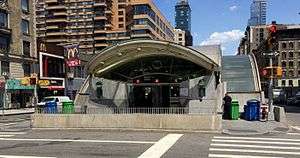
As 96th Street is a major transfer point, there are two sets of entrances and exits at the station.[18] For the purposes of this article, entrance and exit are interchangeable. It is important to note that unlike more recent stations with full-length mezzanines, these entrance points are not connected; they can only be reached from the ends of the platforms. These distinctions are noted on the platforms.

- Original 96th Street exits (closed): There were two staircases each at the southeastern and southwestern corners of 96th Street and Broadway.[19][lower-alpha 1] Although fare control was at platform-level (on the unused side platforms), there was a free cross-under at this end of the station upon entering the paid area. This setup occurred due to an important sewer pipe that prevented engineers from building a mezzanine level similar to other express stations. The staircases were closed when the headhouse was opened on April 5, 2010, but a part of the original cross-under inside the fare control still exists.[6][lower-alpha 1]
- 93rd–94th Street exits: There are two staircases each at the southeastern and southwestern corners of 94th Street and Broadway.[19] There is a crossover within fare control at this end of the station.
In popular culture
96th Street Station is the location of a chase scene in the 1979 cult film The Warriors. However, the scenes were actually filmed at the unused outer tracks of the Hoyt–Schermerhorn Streets station on the IND Fulton Street Line in Brooklyn. The exterior shots were filmed at the 72nd Street station.[20]
Notes
- 1 2 Google Maps Street View picture of the exits in 2009.
The same intersection in 2015. The exits don't exist.
References
- 1 2 "Our Subway Open: 150,000 Try It". The New York Times. October 28, 1904 – via nycsubway.org.
- ↑ "Station Developers' Information". Metropolitan Transportation Authority. Retrieved June 13, 2017.
- ↑ "NYC Subway Wireless – Active Stations". Transit Wireless Wifi. Retrieved May 18, 2016.
- ↑ "Facts and Figures: Annual Subway Ridership 2012–2017". Metropolitan Transportation Authority. July 12, 2018. Retrieved July 12, 2018.
- ↑ Some subway ifs and don'ts The New York Times (on NYCSubway) Retrieved 2008-09-01
- 1 2 3 4 5 6 96th Street NYCSubway Retrieved 2008-09-01
- ↑ New York City Subway chaining Archived April 5, 2008, at the Wayback Machine. TheJoeKorner Retrieved 2008-09-01
- ↑ Forgotten NY New York's Beaux-Arts Bathrooms
- ↑ Gargan, Edward A. (June 11, 1981). "Agency Lists its 69 Most Deteriorated Subway Stations". The New York Times. Retrieved 13 August 2016.
- ↑ Joey Arak (2008-09-16). "Subway Station of the Future Opens on Upper West Side". Curbed. Retrieved 2013-08-23.
- ↑ Joey Arak (2009-04-29). "Cash-Strapped MTA Tinkering With New 96th Street Station". Curbed. Retrieved 2013-08-23.
- ↑ Haddon, Heather (28 April 2009). "MTA shaves cost, features from 96th Street station rehab". amNew York. Archived from the original on 3 May 2009.
- ↑ Joey Arak (2010-04-05). "Subway Station of the Future Opens on Upper West Side". Curbed. Retrieved 2013-08-23.
- ↑ MTA presentation to Manhattan community board 7
- ↑ Leslie Albrecht (November 8, 2010). "Months After Grand Opening, MTA Says Elevators at 96th Street Station To Open Tuesday". DNAinfo. Archived from the original on 9 November 2010. Retrieved November 10, 2010.
- ↑ 96th Street sidewalk models make us believe Curbed Retrieved 2007-09-01 Archived September 28, 2007, at the Wayback Machine.
- ↑ Pete Donohue (2014-04-05). "Treacherous intersection of W. 96th St. and Broadway getting a safety-promoting overhaul: DOT officials". Daily News. Retrieved 2014-08-23.
- ↑ "MTA Neighborhood Maps: Upper West Side and Central park" (PDF). mta.info. Metropolitan Transportation Authority. 2015. Retrieved 30 September 2015.
- 1 2 96th Street station OnNYTurf Retrieved 2008-09-01 Archived 2009-08-13 at the Wayback Machine.
- ↑ http://www.scoutingny.com/the-new-york-city-filming-locations-of-the-warriors-part-3/
External links
| Wikimedia Commons has media related to 96th Street (IRT Broadway – Seventh Avenue Line). |
|
|
- nycsubway.org – IRT West Side Line: 96th Street
- MTA Opens New UWS Subway Entrance. NY1 local news channel. Retrieved April 5, 2010.
- Station Reporter – 1 Train
- Station Reporter – 2 Train
- Station Reporter – 3 Train
- Forgotten NY – Original 28 – NYC's First 28 Subway Stations
- MTA's Facebook Web Page – 96th Street Pictures. Retrieved April 6, 2010.
- MTA's Arts for Transit – 96th Street (IRT Broadway–Seventh Avenue Line)
- Head house from 96th Street from Google Maps Street View
- Head house from 95th Street from Google Maps Street View
- 94th Street entrance from Google Maps Street View
- Lobby from Google Maps Street View
- Platforms from Google Maps Street View
- Abandoned Stations – Abandoned Stations – 96 St platforms
